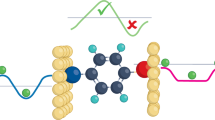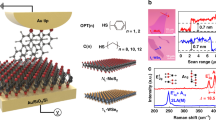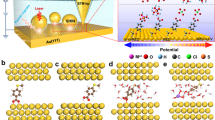Abstract
Although molecular rectifiers were proposed over four decades ago1,2, until recently reported rectification ratios (RR) were rather moderate2,3,4,5,6,7,8,9,10,11 (RR ~ 101). This ceiling was convincingly broken using a eutectic GaIn top contact12 to probe molecular monolayers of coupled ferrocene groups (RR ~ 105), as well as using scanning tunnelling microscopy-break junctions13,14,15,16 and mechanically controlled break junctions17 to probe single molecules (RR ~ 102–103). Here, we demonstrate a device based on a molecular monolayer in which the RR can be switched by more than three orders of magnitude (between RR ~ 100 and RR ≥ 103) in response to humidity. As the relative humidity is toggled between 5% and 60%, the current–voltage (I–V) characteristics of a monolayer of di-nuclear Ru-complex molecules reversibly change from symmetric to strongly asymmetric (diode-like). Key to this behaviour is the presence of two localized molecular orbitals in series, which are nearly degenerate in dry circumstances but become misaligned under high humidity conditions, due to the displacement of counter ions (PF6 –). This asymmetric gating of the two relevant localized molecular orbital levels results in humidity-controlled diode-like behaviour.
This is a preview of subscription content, access via your institution
Access options
Access Nature and 54 other Nature Portfolio journals
Get Nature+, our best-value online-access subscription
$29.99 / 30 days
cancel any time
Subscribe to this journal
Receive 12 print issues and online access
$259.00 per year
only $21.58 per issue
Buy this article
- Purchase on Springer Link
- Instant access to full article PDF
Prices may be subject to local taxes which are calculated during checkout





Similar content being viewed by others
References
Aviram, A. & Ratner, M. Molecular rectifiers. Chem. Phys. Lett. 29, 277–283 (1974).
Metzger, R. M. Unimolecular electrical rectifiers. Chem. Rev. 103, 3803–3834 (2003).
McCreery, R. L. & Bergren, A. J. Progress with molecular electronic junctions: meeting experimental challenges in design and fabrication. Adv. Mater. 21, 4303–4322 (2009).
Yasuda, S., Nakamura, T., Matsumoto, M. & Shigekawa, H. Phase switching of a single isomeric molecule and associated characteristic rectification. J. Am. Chem. Soc. 125, 16430–16433 (2003).
Kitagawa, K., Morita, T. & Kimura, S. Molecular rectification of a helical peptide with a redox group in the metal-molecule-metal junction. J. Phys. Chem. B 109, 13906–13911 (2005).
Loertscher, E. et al. Transport properties of a single-molecule diode. ACS Nano 6, 4931–4939 (2012).
Diez–Perez, I. et al. Rectification and stability of a single molecular diode with controlled orientation. Nat. Chem. 1, 635–641 (2009).
Batra, A. et al. Tuning rectification in single-molecular diodes. Nano Lett. 13, 6233–6237 (2013).
Elbing, M. et al. A single-molecule diode. Proc. Natl Acad. Sci. USA 102, 8815–8820 (2005).
Guo, C. et al. Molecular rectifier composed of DNA with high rectification ratio enabled by intercalation. Nat. Chem. 8, 484–490 (2016).
Terada, K., Kobayashi, K., Hikita, J. & Haga, M.-A. Electric conduction properties of self-assembled monolayer films of Ru complexes with disulfide/phosphonate anchors in a Au-(molecular ensemble)-(Au nanoparticle) junction. Chem. Lett. 38, 416–417 (2009).
Chen, X. et al. Molecular diodes with rectification ratios exceeding 105 driven by electrostatic interactions. Nat. Nanotech. 12, 797–803 (2017).
Capozzi, B. et al. Single-molecule diodes with high rectification ratios through environmental control. Nat. Nanotech. 10, 522–527 (2015).
Aragonès, A. C. et al. Single-molecule electrical contacts on silicon electrodes under ambient conditions. Nat. Commun. 8, 15056 (2017).
Cheung, K. C. M., Chen, X. Y., Albrecht, T. & Kornyshev, A. A. Principles of a single-molecule rectifier in electrolytic environment. J. Phys. Chem. C 120, 3089–3106 (2016).
Sherif, S. et al. Current rectification in a single molecule diode: the role of electrode coupling. Nanotechnology 26, 291001 (2015).
Perrin, M. L. et al. A gate-tunable single-molecule diode. Nanoscale 8, 8927–8931 (2016).
Choi, S. H., Kim, B. & Frisbie, C. D. Electrical resistance of long conjugated molecular wires. Science 320, 1482–1486 (2008).
Guedon, C. M. et al. Observation of quantum interference in molecular charge transport. Nat. Nanotech. 7, 304–308 (2012).
Luo, L. et al. Length and temperature dependent conduction of ruthenium-containing redox-active molecular wires. J. Phys. Chem. C 115, 19955–19961 (2011).
Kaliginedi, V. et al. Layer-by-layer grown scalable redox-active ruthenium-based molecular multilayer thin films for electrochemical applications and beyond. Nanoscale 7, 17685–17692 (2015).
Nagashima, T. et al. Photoresponsive molecular memory films composed of sequentially assembled heterolayers containing ruthenium complexes. Chem. Eur. J. 22, 1658–1667 (2016).
Mohos, M. et al. Breaking force and conductance of gold nanojunctions: effect of humidity. J. Phys. Chem. Lett. 5, 3560–3564 (2014).
Perrin, M. L. Large negative differential conductance in single molecule break junctions. Nat. Nanotech. 9, 830–834 (2014).
te Velde, G. et al. Chemistry with ADF. J. Comp. Chem. 22, 931–967 (2001).
Guerra, C. F., Snijders, J. G., te Velde, G. & Baerends, E. J. Towards an order-N DFT method. Theor. Chem. Acc. 99, 391–403 (1998).
Poot, M. et al. Temperature dependence of three-terminal molecular junctions with sulfur end-functionalized tercyclohexylidenes. Nano Lett. 6, 1031–1035 (2006).
Bergren, A. J., McCreery, R. L., Stoyanov, S. R., Gusarov, S. & Kovalenko, A. Electronic characteristics and charge transport mechanisms for large area aromatic molecular junctions. J. Phys. Chem. C 114, 15806–15815 (2010).
Schwarz, F. et al. Field-induced conductance switching by charge-state alternation in organometallic single-molecule junctions. Nat. Nanotech. 11, 170–176 (2016).
Allnat, A. R. & Lidiard, A. B. Atomic Transport in Solids 180–185 (Cambridge Univ., Cambridge 1993).
Terada, K. et al. Memory effects in molecular films of free-standing rod-shaped ruthenium complexes on an electrode. Angew. Chem. Int. Ed. 50, 6287–6291 (2011).
Quek, S. Y. et al. Amine-gold linked single-molecule circuits: experiment and theory. Nano Lett. 7, 3477–3482 (2007).
Mowbray, D. J., Jones, G. & Thygesen, K. S. Influence of functional groups on charge transport in molecular junctions. J. Chem. Phys. 128, 111103 (2008).
Pye, C. C., Ziegler, T., van Lenthe, E. & Louwen, J. N. An implementation of the conductor-like screening model of solvation within the Amsterdam density functional package: Part II. COSMO for real solvents (1). Can. J.Chem. 87, 790–797 (2009).
Acknowledgements
We thank F. Galli for technical support and advice. We acknowledge financial support from the Swiss National Science Foundation (grant no. 200020-144471), as well as from the JSPS KAKENHI (grant no. JP17H05383; Coordination Asymmetry, Japan) and the Science Research Promotion Fund from the Promotion and Mutual Aid Corporation for Private Schools of Japan, and from the Netherlands Organisation for Scientific Research (NWO) via FOM programme no. 141.
Author information
Authors and Affiliations
Contributions
H.O. and M.H. designed and synthesized the molecules. H.A., V.K., P.B., H.O. and M.H. characterized the SAMs. H.A. and V.K. performed the C-AFM measurements. H.A., V.K. and S.J.v.d.M. designed the experiment and performed data analysis. J.A.C.G. and J.M.T. performed the calculations. H.A., V.K., J.A.C.G., J.M.T. and S.J.v.d.M. co-wrote the paper. All authors discussed the results and commented on the manuscript.
Corresponding authors
Ethics declarations
Competing interests
The authors declare no competing financial interests.
Additional information
Publisher’s note: Springer Nature remains neutral with regard to jurisdictional claims in published maps and institutional affiliations.
Electronic supplementary material
Rights and permissions
About this article
Cite this article
Atesci, H., Kaliginedi, V., Celis Gil, J.A. et al. Humidity-controlled rectification switching in ruthenium-complex molecular junctions. Nature Nanotech 13, 117–121 (2018). https://doi.org/10.1038/s41565-017-0016-8
Received:
Accepted:
Published:
Issue Date:
DOI: https://doi.org/10.1038/s41565-017-0016-8
This article is cited by
-
Nanoscale molecular rectifiers
Nature Reviews Chemistry (2023)
-
Non-covalent interaction-based molecular electronics with graphene electrodes
Nano Research (2023)
-
Sub-nanometer supramolecular rectifier based on the symmetric building block with destructive σ-interference
Science China Chemistry (2021)
-
Electric-field-driven dual-functional molecular switches in tunnel junctions
Nature Materials (2020)
-
Two-dimensional inorganic molecular crystals
Nature Communications (2019)



